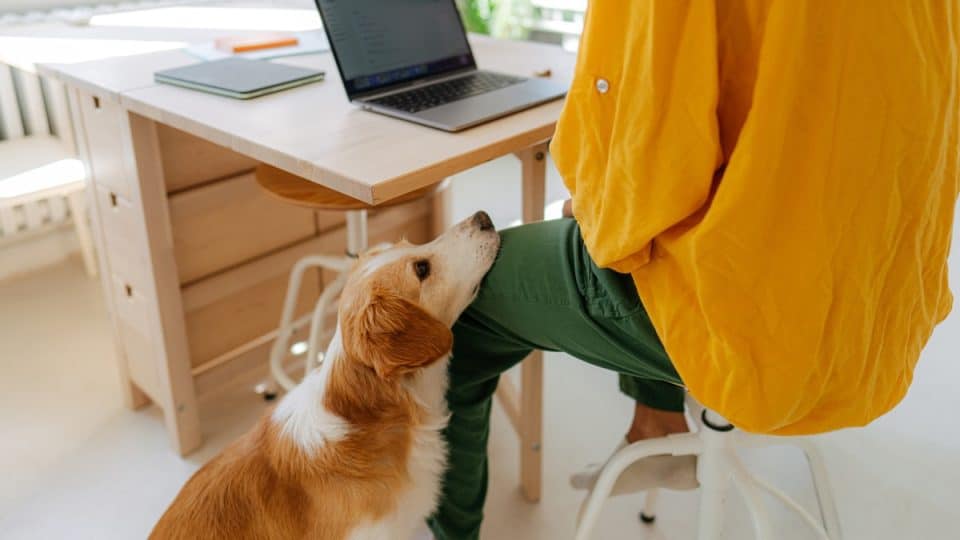- Not a substitute for professional veterinary help.
If your pup has been acting out, gaining weight, or doesn’t seem like themselves lately, these could all be signs that your dog isn’t getting enough exercise.
When dogs don’t get enough physical activity, it can harm their physical health and increase their likelihood of developing behavioral issues, such as excessive barking or chewing.
“Exercise can help burn off extra energy, making your dog less likely to exhibit destructive behavior because of boredom,” says Dr. Marc Smith, veterinarian and owner of Natchez Trace Veterinary Services. Exercise isn’t just good for the body—it’s good for the mind, too!
In this article, we’ll break down what happens if a dog doesn’t get enough exercise, how to tell if they’re not getting enough activity, and what you can do to ensure they get plenty of movement throughout the day.
Weight Gain
When dogs don’t burn the calories they consume, this energy imbalance can lead to weight gain, especially in dogs already prone to it.
Excess weight can reduce your dog’s energy and strain their joints. Recent studies also show that obesity in dogs can lead to long-term health problems like diabetes and heart disease.
Regular exercise helps manage your dog’s weight by increasing calorie burn and supporting a healthy metabolism. It also helps build muscle, which keeps your dog lean and strong. If you notice your pup gaining weight, a more active routine can make a big difference. Add a bit more time to your walks and incorporate more play sessions into your day.
Note: Certain diseases and disorders can also lead to rapid weight gain. Always consult your veterinarian if your dog’s weight suddenly changes, and before embarking on a weight loss plan.
Destructive Behavior
A bored dog will find ways to entertain themselves if they don’t have a healthy outlet for their energy. This lack of physical stimulation often causes them to create their own fun, like chewing furniture, digging holes, or tearing up your belongings.
Not only does this behavior lead to damage to your property, but it can also pose significant safety risks for your dog. Chewing on electrical cords could shock your dog or create a fire hazard, and ingesting chunks of your shoe, underwear, or couch could cause an intestinal blockage.
Regular physical activity provides a safe way for your dog to burn off energy. Giving them a job can also help them feel more fulfilled and minimize destructive behavior. These physical tasks can look as simple as giving your dog a puzzle toy to move around and solve. Or they can be as advanced as incorporating more breed-specific activities into your dog’s life, like teaching a Golden Retriever to find, pick up, and put away their toys.

Iuliia Zavalishina via iStock
Hyperactivity or Excitement
If your dog seems overly excited all the time, they might have too much pent-up energy. Dogs who can’t get their zoomies out or quiet their mind often struggle to settle down.
This constant state of high arousal can make daily life stressful for both you and your dog. It may make training more challenging and lead to behavioral issues, such as reactivity.
The catch here, however, is that some types of high-energy exercise, like fetch or tug, may only amp your dog up. Instead, try incorporating more low-impact movements, such as slow, sniffy decompression walks or focused training sessions, to help bring your dog’s arousal and excitement level down.
Practicing calming activities, such as scattering treats to snuffle in the grass or going through the relaxation protocol, after vigorous exercise can also help your dog learn how to self-regulate when overly excited.
Increased Whining or Barking
Another effect of not walking or exercising your dog enough is increased vocalization. Whining and barking are common ways dogs communicate that they’re frustrated, restless, or want something. Your pup may also be on higher alert if their needs aren’t met—and so be more likely to notice (and be offended by) the mail carrier and other triggers.
Constant whining and barking can make you, your dog, and other pets and family members feel on edge at home. If the noise is loud enough, it could also lead to complaints from neighbors, especially if you live in close quarters, such as an apartment.
Dr. Smith says physical activity, especially outside, exposes your dog to different types of environmental stimuli and helps eliminate pent-up energy that often leads to unnecessary barking. Remember, both exercise and mental enrichment are crucial to satisfying your dog’s physical and emotional needs.
Sluggishness or Depression
Just like people, dogs can experience depressive moods when their needs aren’t met. When dogs aren’t engaging in activities they love or moving their bodies regularly, they miss out on the endorphins that make them feel good.
Without sufficient physical stimulation, dogs may appear disinterested in play, sleep excessively, or withdraw from engaging with family members. This emotional slump can lead to more serious mental and physical health issues if it continues long-term.
Whether it’s walking, running, playing games, or spending time sniffing outside, regular activity helps boost your dog’s mood. In fact, studies show that more active dogs show happier, more excited behavior towards their guardians, suggesting that physical activity supports a dog’s emotional stability.
Note: Sudden loss of interest in activities or engaging with family members can be a sign of illness or a more serious health condition. Consult your veterinarian if you’re concerned about a sudden behavior change.

Corey O’Hara via iStock
Soreness or Stiffness
One way to tell if dogs, especially older dogs or pups with joint issues, are not getting enough exercise is if they start having difficulty jumping on the couch or going up the stairs. It might seem surprising, but dogs who don’t move enough can become stiff or sore. Without regular activity, muscles weaken, and joints become tighter, especially in older dogs.
This discomfort may make your dog less likely to move, creating a cycle of inactivity that can potentially lead to pain if left unaddressed.
Gentle, consistent exercise can improve flexibility, strengthen muscles, and reduce stiffness. It also supports joint health by promoting circulation and mobility, so even senior dogs benefit from daily movement.
Rough Play
Sure, some dogs are more rough-and-tumble than others. But if your dog is playing too hard, getting overly mouthy, or seems to lack self-control, they may have too much energy stored up.
This kind of behavior can make socialization with other people and pets more difficult, says Dr. Smith. It can also lead to pet parents isolating their dogs from people and animals because their dog’s behavior is so unpredictable.
Regular physical activity helps your dog release that extra energy in more appropriate outlets. When their exercise needs are met, dogs tend to play more calmly and are better able to read the social cues of other dogs.
Anxiety
Anxiety is another sign your dog is not getting enough physical attention. Studies show that an under-exercised dog is more likely to feel stressed, especially in unfamiliar or overstimulating environments.
Symptoms of anxiety may include trembling, excessive licking, barking, or trying to escape. Over time, anxiety can take a toll on your dog’s overall health and make it harder for them to feel safe and secure.
Exercise, however, can be a powerful tool for easing anxiety, says Dr. Smith. “Exercise can actually reduce the cortisol levels in your dog,” he explains. “Cortisol is directly associated with stress and anxiety. Lowering the cortisol levels can help your pet release endorphins, leading to a happier and less anxious dog.”
Tips for Increasing Your Dog’s Exercise
Adding more activity to your dog’s routine can do wonders. However, Dr. Smith emphasizes the importance of doing it safely. “Dogs are like humans in that they can injure themselves after not exercising for a while,” he explains. “Just like us, dogs can tear muscles, overheat, have joint issues, or even stress out their heart.”
Here are a few tips to safely increase your dog’s exercise without putting their health at risk or overdoing it:
- Start slowly. Jumping immediately into longer walks or intense play can lead to sprains, tears, or overheating, especially if your dog hasn’t been active in a while.
- Pay attention to age and body condition. Older or obese dogs need to move at a slower pace than young or high-energy dogs.
- Watch the weather. Avoid exercising in the hottest part of the day, especially in the summer. Dogs can overheat quickly, even on short walks.
- Offer plenty of water. Always bring fresh water on walks or outdoor play sessions, and give your dog time to rest if they seem tired or overstimulated.
- Listen to your dog. Limping, slowing down, heavy panting, or reluctance to engage in an activity are signs it’s time to stop and reassess your exercise plan.



